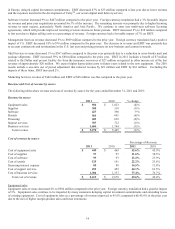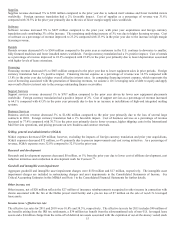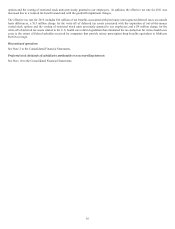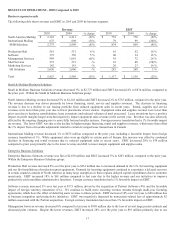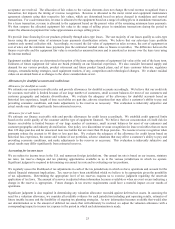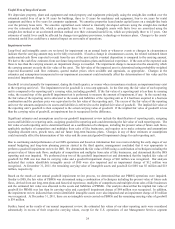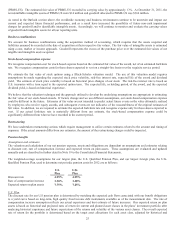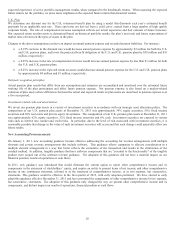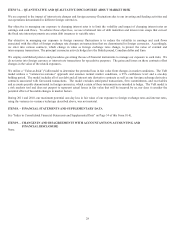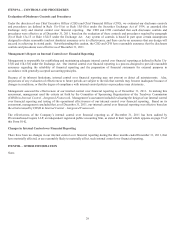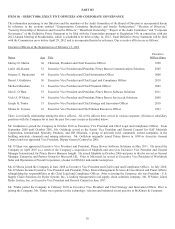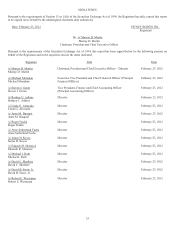Pitney Bowes 2011 Annual Report Download - page 42
Download and view the complete annual report
Please find page 42 of the 2011 Pitney Bowes annual report below. You can navigate through the pages in the report by either clicking on the pages listed below, or by using the keyword search tool below to find specific information within the annual report. 24
Useful lives of long-lived assets
We depreciate property, plant and equipment and rental property and equipment principally using the straight-line method over the
estimated useful lives of up to 50 years for buildings, three to 15 years for machinery and equipment, four to six years for rental
equipment and three to five years for computer equipment. We amortize properties leased under capital leases on a straight-line basis
over the primary lease term. We amortize capitalized costs related to internally developed software using the straight-line method
over the estimated useful life, which is principally three to 10 years. Intangible assets with finite lives are amortized using the
straight-line method or an accelerated attrition method over their estimated useful lives, which are principally three to 15 years. Our
estimates of useful lives could be affected by changes in regulatory provisions, technology or business plans. Changes to the assets’
estimated useful lives could have a material impact on our results of operations.
Impairment review
Long-lived and intangible assets are reviewed for impairment on an annual basis or whenever events or changes in circumstances
indicate that the carrying amount may not be fully recoverable. If such a change in circumstances occurs, the related estimated future
undiscounted cash flows expected to result from the use of the asset and its eventual disposition is compared to the carrying amount.
We derive the cash flow estimates from our future long-term business plans and historical experience. If the sum of the expected cash
flows is less than the carrying amount, an impairment charge is recorded. The impairment charge is measured as the amount by which
the carrying amount exceeds the fair value of the asset. The fair value of the impaired asset is determined using probability weighted
expected discounted cash flow estimates, quoted market prices when available and appraisals, as appropriate. Changes in the
estimates and assumptions incorporated in our impairment assessment could materially affect the determination of fair value and the
associated impairment charge.
Goodwill is tested annually for impairment, during the fourth quarter, or sooner when circumstances indicate an impairment may exist
at the reporting unit level. The impairment test for goodwill is a two-step approach. In the first step, the fair value of each reporting
unit is compared to the reporting unit’s carrying value, including goodwill. If the fair value of a reporting unit is less than its carrying
value, the second step of the goodwill impairment test is performed to measure the amount of impairment, if any. In the second step,
the fair value of the reporting unit is allocated to the assets and liabilities of the reporting unit as if it had been acquired in a business
combination and the purchase price was equivalent to the fair value of the reporting unit. The excess of the fair value of the reporting
unit over the amounts assigned to its assets and liabilities is referred to as the implied fair value of goodwill. The implied fair value of
the reporting unit’s goodwill is then compared to the actual carrying value of goodwill. If the implied fair value of goodwill is less
than the carrying value of goodwill, an impairment loss is recognized for the difference.
Significant estimates and assumptions used in our goodwill impairment review include the identification of reporting units, assigning
assets and liabilities to reporting units, assigning goodwill to reporting units and determining the fair value of each reporting unit. The
fair value of each reporting unit is determined based on a combination of techniques, including the present value of future cash flows,
applicable multiples of competitors and multiples from sales of like businesses, and requires us to make estimates and assumptions
regarding discount rates, growth rates, and our future long-term business plans. Changes in any of these estimates or assumptions
could materially affect the determination of fair value and the associated goodwill impairment charge for each reporting unit.
Due to continuing underperformance of our IMS operations and based on information that was received during the early stages of our
annual budgeting and long-term planning process started in the third quarter, management concluded that it was appropriate to
perform a goodwill impairment review for IMS. We determined the fair value of IMS using a combination of techniques including the
present value of future cash flows, multiples of competitors and multiples from sales of like businesses, and determined that the IMS
reporting unit was impaired. We performed step two of the goodwill impairment test and determined that the implied fair value of
goodwill for IMS was less than its carrying value and a goodwill impairment charge of $46 million was recognized. Our analysis
indicated that certain identifiable intangible assets of IMS were also impaired and an impairment charge of $12 million was
recognized. At December 31, 2011, the remaining carrying value of intangible assets and goodwill for IMS was $5 million and $18
million, respectively.
Based on the results of our annual goodwill impairment review process, we determined that our PBMSi operations were impaired.
Similar to IMS, the fair value of PBMSi was determined using a combination of techniques including the present value of future cash
flows, derived from our long-term plans and historical experience, multiples of competitors and multiples from sales of like businesses
and the estimated fair value was allocated to the assets and liabilities of PBMSi. Our analysis showed that the implied fair value of
goodwill for PBMSi was less than its carrying value and a goodwill impairment charge of $84 million was recognized. In addition,
the impairment review indicated that certain identifiable intangible assets were also impaired and an impairment charge of $5 million
was recognized. At December 31, 2011, there are no intangible assets carried on PBMSi and the remaining carrying value of goodwill
is $39 million.
Further, based on the results of our annual impairment review, the estimated fair values of our other reporting units were considered
substantially in excess of their respective carrying values, except for the U.S. operations of our Management Services segment


